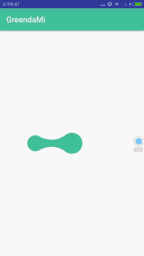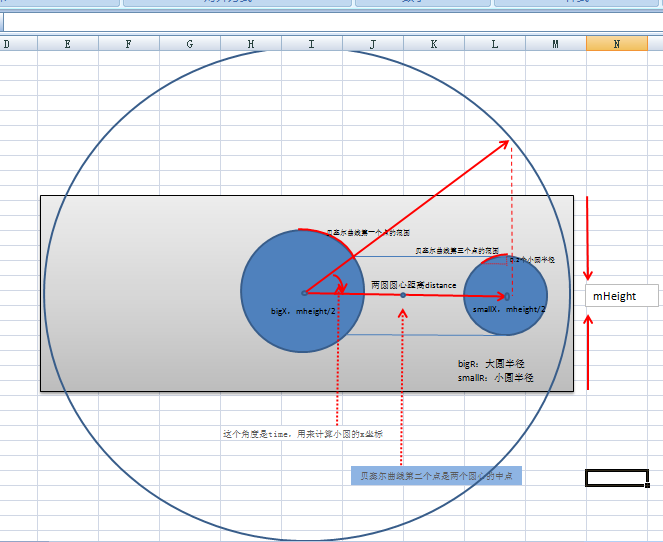您好,登录后才能下订单哦!
小编给大家分享一下Android如何实现一个带粘连效果的LoadingBar,相信大部分人都还不怎么了解,因此分享这篇文章给大家参考一下,希望大家阅读完这篇文章后大有收获,下面让我们一起去了解一下吧!
前言
我们平时在开发的时候,发起网络请求前,会需要显示一个Loading,一般的做法都是在xml布局上添加好Loading,然后在Activity中,setVisibility来控制Loading的显示和隐藏,这样使用起来就很不方便,因为每一个xml都得引入一个Loading布局。
而LoadingBar就更好的解决了这个问题
最近设计师在外国的一个网站上挑了一个Loading的效果图,尝试实现之后,虽然和原图有点不太一样,但是效果还是不错的。难点就是粘连效果的实现,贝塞尔曲线的点点们简直要把我折磨死了。
先上效果图:

实例代码
然后是源码,就是一个简单VIew,可以直接放在xml中使用。
package top.greendami.greendami;
import android.content.Context;
import android.graphics.Canvas;
import android.graphics.Paint;
import android.graphics.Path;
import android.support.annotation.Nullable;
import android.util.AttributeSet;
import android.view.View;
/**
* Created by GreendaMi on 2017/3/17.
*/
public class PPView extends View {
String TAG = "PPView";
//动画开关
boolean isLoading = true;
Context mContext;
private int mWidth = 100;
private int mheight = 100;
public int mColor;
public Paint mPaint = new Paint();
float time = 0;
//小球与中间打球的最远距离
float distance = 100;
public PPView(Context context) {
super(context);
mContext = context;
}
public PPView(Context context, @Nullable AttributeSet attrs) {
super(context, attrs);
mContext = context;
mColor = context.getResources().getColor(R.color.colorPrimary);
init();
}
private void init() {
mPaint.setAntiAlias(true);
mPaint.setColor(mColor);
}
@Override
protected void onMeasure(int widthMeasureSpec, int heightMeasureSpec) {
super.onMeasure(widthMeasureSpec, heightMeasureSpec);
int widthSpecSize = MeasureSpec.getSize(widthMeasureSpec);
int heightSpecSize = MeasureSpec.getSize(heightMeasureSpec);
//宽度至少是高度的4倍
if (widthSpecSize < 4 * heightSpecSize) {
widthSpecSize = 4 * heightSpecSize;
}
mWidth = widthSpecSize;
mheight = heightSpecSize;
distance = 1.2f * mheight;
setMeasuredDimension(widthSpecSize, heightSpecSize);
}
@Override
protected void onDraw(Canvas canvas) {
super.onDraw(canvas);
if (isLoading) {
//大圆半径
float bigR = mheight * 0.32f + mheight * 0.03f * Math.abs((float) Math.sin(Math.toRadians(time)));
float smallR = mheight * 0.22f + mheight * 0.03f * Math.abs((float) Math.cos(Math.toRadians(time)));
float bigx = (getWidth()) / 2;
//画中间大圆
canvas.drawCircle(bigx, mheight / 2, bigR, mPaint);
float smalx = getSmallCenterX();
//画小圆
canvas.drawCircle(smalx, mheight / 2, smallR, mPaint);
//画链接
//小球在右侧
if (smalx > bigx) {
Path path = new Path();
//上面的贝塞尔曲线的第一个点,在大圆身上
float x1 = bigx + bigR * (float) Math.cos(Math.toRadians(time));
float y1 = mheight / 2 - bigR * (float) Math.sin(Math.toRadians(time));
if (y1 > mheight / 2 - smallR) {
y1 = mheight / 2 - smallR;
x1 = bigx + (float) (Math.sqrt(bigR * bigR - smallR * smallR));
}
//上面的贝塞尔曲线的第三个点,在小圆身上
float x2 = smalx - smallR * (float) Math.cos(Math.toRadians(time));
float y2 = mheight / 2 - smallR * (float) Math.sin(Math.toRadians(time));
if (y2 > mheight / 2 - smallR * 0.8) {
y2 = mheight / 2 - smallR * 0.8f;
x2 = smalx - smallR * (float) (Math.sqrt(1-0.64f));
}
//下面的贝塞尔曲线的第三个点,在小圆身上
float x3 = smalx - smallR * (float) Math.cos(Math.toRadians(time));
float y3 = mheight / 2 + smallR * (float) Math.sin(Math.toRadians(time));
if (y3 < mheight / 2 + smallR * 0.8) {
y3 = mheight / 2 + smallR * 0.8f;
x3 = smalx - smallR * (float) (Math.sqrt(1-0.64f));
}
//下面的贝塞尔曲线的第一个点,在大圆身上
float x4 = bigx + bigR * (float) Math.cos(Math.toRadians(time));
float y4 = mheight / 2 + bigR * (float) Math.sin(Math.toRadians(time));
if (y4 < mheight / 2 + smallR) {
y4 = mheight / 2 + smallR;
x4 = bigx + (float) (Math.sqrt(bigR * bigR - smallR * smallR));
}
path.moveTo(x1, y1);
path.quadTo((bigx + smalx) / 2, mheight / 2, x2, y2);
// 绘制贝赛尔曲线(Path)
path.lineTo(x3, y3);
path.quadTo((bigx + smalx) / 2, mheight / 2, x4, y4);
canvas.drawPath(path, mPaint);
}
//小球在左侧
if (smalx < bigx) {
Path path = new Path();
float x1 = bigx + bigR * (float) Math.cos(Math.toRadians(time));
float y1 = mheight / 2 - bigR * (float) Math.sin(Math.toRadians(time));
if (y1 > mheight / 2 - smallR) {
y1 = mheight / 2 - smallR;
x1 = bigx - (float) (Math.sqrt(bigR * bigR - smallR * smallR));
}
float x2 = smalx - smallR * (float) Math.cos(Math.toRadians(time));
float y2 = mheight / 2 - smallR * (float) Math.sin(Math.toRadians(time));
if (y2 > mheight / 2 - smallR * 0.8) {
y2 = mheight / 2 - smallR * 0.8f;
x2 = smalx + smallR * (float) (Math.sqrt(1-0.64f));
}
float x3 = smalx - smallR * (float) Math.cos(Math.toRadians(time));
float y3 = mheight / 2 + smallR * (float) Math.sin(Math.toRadians(time));
if (y3 < mheight / 2 + smallR * 0.8) {
y3 = mheight / 2 + smallR * 0.8f;
x3 = smalx + smallR * (float) (Math.sqrt(1-0.64f));
}
float x4 = bigx + bigR * (float) Math.cos(Math.toRadians(time));
float y4 = mheight / 2 + bigR * (float) Math.sin(Math.toRadians(time));
if (y4 < mheight / 2 + smallR) {
y4 = mheight / 2 + smallR;
x4 = bigx - (float) (Math.sqrt(bigR * bigR - smallR * smallR));
}
path.moveTo(x1, y1);
path.quadTo((bigx + smalx) / 2, mheight / 2, x2, y2);
// 绘制贝赛尔曲线(Path)
path.lineTo(x3, y3);
path.quadTo((bigx + smalx) / 2, mheight / 2, x4, y4);
canvas.drawPath(path, mPaint);
}
postInvalidate();
}
}
//计算小球的X坐标
private float getSmallCenterX() {
//此处控制速度
time = time + 2.5f;
return mWidth / 2 + distance * (float) Math.cos(Math.toRadians(time));
}
}“精心”画了一张图,对代码做了说明。

在代码中使用
<?xml version="1.0" encoding="utf-8"?> <RelativeLayout xmlns:android="http://schemas.android.com/apk/res/android" xmlns:tools="http://schemas.android.com/tools" android:layout_width="match_parent" android:layout_height="match_parent" android:background="@color/white" tools:context="top.greendami.greendami.MainActivity"> <top.greendami.greendami.PPView android:layout_centerInParent="true" android:layout_width="400dp" android:layout_height="80dp" /> </RelativeLayout>
以上是“Android如何实现一个带粘连效果的LoadingBar”这篇文章的所有内容,感谢各位的阅读!相信大家都有了一定的了解,希望分享的内容对大家有所帮助,如果还想学习更多知识,欢迎关注亿速云行业资讯频道!
免责声明:本站发布的内容(图片、视频和文字)以原创、转载和分享为主,文章观点不代表本网站立场,如果涉及侵权请联系站长邮箱:is@yisu.com进行举报,并提供相关证据,一经查实,将立刻删除涉嫌侵权内容。